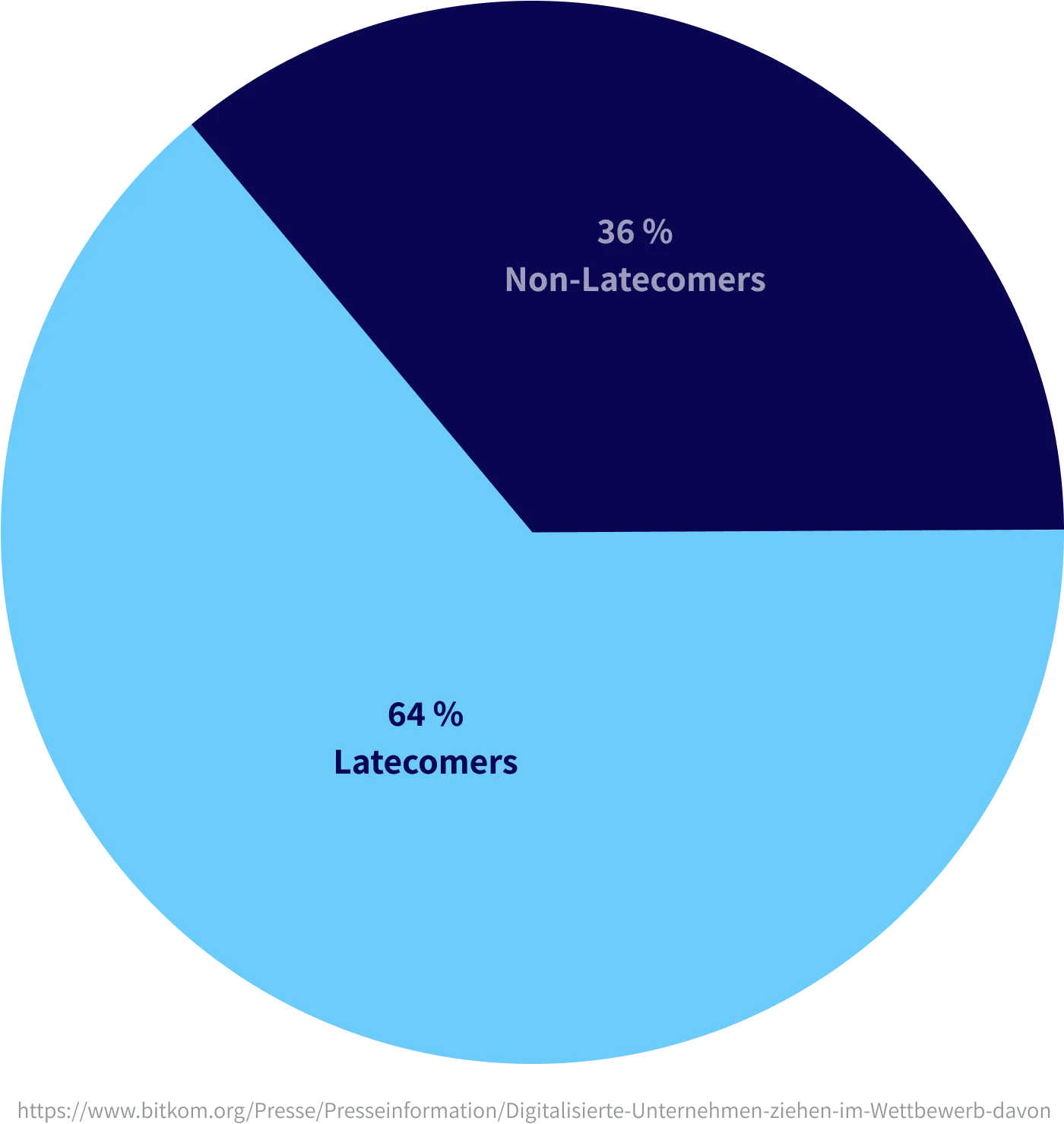If you don't continue to digitize, you'll lose.

Why digitalization keeps you competitive
Skilled workers are in short supply, spending on wages and ancillary costs is rising, boomers are retiring, customers expect a personalized approach and a high-quality user experience ... All of this is keeping companies busy. But how can the economy maintain productivity levels and growth in this situation?
The digitalization of business processes, including in marketing and sales, provides a key. Countless surveys and studies, such as those conducted by Bitkom e.V.*, prove just how crucial this is:
Does early digitalization give companies a competitive edge today?

Is your own company a latecomer to digitalization?

Does digital technology play a decisive role in competitiveness?

The fact that digitalization is a decisive factor is clear to the vast majority of business players. But how can it be achieved - and which steps will benefit you most quickly and efficiently when it comes to sales and marketing?
The 5 pillars of an efficient and holistic digitalization strategy
The digitalization of marketing and sales brings leaner and faster processes as well as more opportunities to inspire customers with personalized services. We are creating digital ecosystems to ensure that all the technologies and systems involved work together seamlessly. They generate synergies and increase productivity and efficiency between the individual technologies.
1. your platform as a digital place of informative added value
Digital ecosystems give you decisive advantages in B2B when interacting with your customers. For example, you can quickly provide them with product details, specifications, availability, etc. on your web platform. PIM integration (PIM = Product Information Management) guarantees up-to-date and consistent data at all times. A networked CRM system enables individual support and automated campaigns - tailored precisely to customer needs.
Your omnichannel marketing is also based on the digital ecosystem. This allows your brand to be experienced consistently on websites as well as via mobile and social media.
You can also integrate knowledge platforms into your digital ecosystem - and thus support your customers and partners with all the information, training, webinars or best practices, optimize their user experience and bind them even more closely to your company.
2. PIM - making complex things easy to communicate
A PIM (Product Information Management) system offers companies considerable advantages through the central management of all product data. This minimizes inconsistencies and data duplicates and significantly improves the quality of product data. The automated, cross-channel export of content increases efficiency and enables a consistent customer experience across all marketing and sales channels.
Multilingual data management simplifies internationalization and localization for different markets. Optimized approval processes also accelerate the time-to-market for product updates; transparent data management also increases compliance and legal certainty.
Conclusion: If you want to optimize your product information processes and customer experience across all channels, a powerful PIM system is a valuable strategic investment with many benefits.
3. DAM - using information and data without limits
Similar to a PIM, digital asset management (DAM) offers significant benefits for sales and marketing. DAM stores digital content (images, videos, documents and graphics) centrally. This allows you to use them efficiently and across all company divisions and channels. The direct provision of information also facilitates day-to-day work for employees and collaboration with partners. The result: greater efficiency and consistency, and not just in communication. High-quality information is quickly available and accelerates conversions.
4. CRM - real customer relationships in the virtual world
What PIM and DAM do for product information and data, a CRM system (CRM = Customer Relationship Management) does for customer data. The CRM system enables a personalized approach by tailoring communication and offers to the individual needs of customers. The effect: the relevance and effectiveness of marketing and sales measures increases. Automated marketing campaigns can be targeted at specific customer segments, increasing the efficiency of marketing activities.
A CRM also improves customer care. Sales employees can immediately access comprehensive customer information and respond more effectively to inquiries. Automated processes reduce the administrative workload, allowing employees to concentrate on value-adding activities. The CRM system also ensures transparency and traceability in the customer life cycle. This makes it easier to track leads and orders. Overall, a CRM system helps to increase customer satisfaction and promote long-term customer relationships.
5. digitizing customer communication - no alternative
Omnichannel communication is becoming increasingly important for B2B companies as it offers a seamless and consistent brand experience across different communication channels. By integrating web, email, messenger, mobile, social media and face-to-face interactions, companies can reach customers where they are most active - and score points with the exact content that solves customer problems.
The importance of omnichannel strategies is also reflected in the forecasts for digital sales: a study by the Mind Digital & Smarter Service Institute shows that 40% of respondents expect digital sales to grow by 50% by 2025. 37.5% of respondents expect growth of between 25% and 50%. These positive expectations highlight the potential of omnichannel strategies to optimize sales and strengthen customer loyalty.
** Source: https://www.sae-portal.de/wachstumsaussichten-des-digitalen-vertriebs-bis-2025
3 other factors that help you gain efficiency:
6. AI - the success factor of the future
AI is not on the rise, it's here. It is a powerful sparring partner and assistant in our everyday lives. It supports us on our way to greater efficiency. We also use it in cooperation with our customers and partners. You can read more about this in our AI Breakdown magazine.
7. Digital branding - because a brand needs a face
Branding shapes the identity and value of a brand. It makes it unique and sets it apart from other providers. A high-profile, distinctive brand creates trust. This aspect in particular is crucial today, as we are bombarded with more advertising messages than ever before. Effective branding also increases brand awareness and increases customer loyalty.
8. e-commerce - also relevant in B2B
For many B2B companies, e-commerce is not yet a focus. However, a web store can also make the decisive difference for efficiency and success in B2B business. This starts with making it easier for customers to place new orders and repeat orders. A web store also simplifies the direct and product-related search for solutions. A survey by E-Commerce Magazine clearly underlines the fact that while the overall turnover of the B2B economy is weakening, B2B e-commerce turnover is growing by between 5 and 10% annually.***
Source: https://www.e-commerce-magazin.de/b2b-ecommerce-wachstum-2024-a-6d123383458bb0e33abe2c2a5b8bd013/

Are you already using your own digital ecosystem?
The world wasn't created in a day - and neither will digital ecosystems. You don't have to implement the entire process at once. You can also tackle networked digitalization step by step or in individual packages. In any case, you will benefit from the intelligent networking of tools and technologies. It is therefore not crucial that you start with a perfect solution. Rather, it is simply a matter of driving your digital efforts forward in order to continue to be successful.
We advise you on building your digital ecosystem and linking your existing infrastructure. This includes integrating digital tools and third-party software into your ecosystem, such as job vacancies from HR software, data sheets from SAP, user data from account management and newsletter subscriptions. Talk to us about this!

